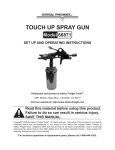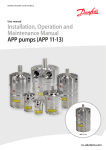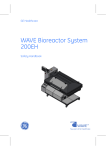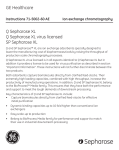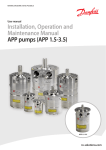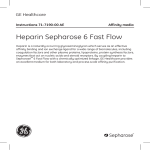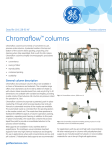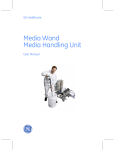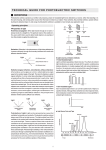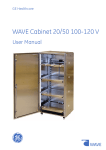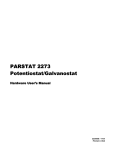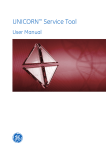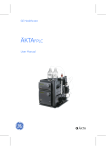Download Handling of stainless steel column parts in sensitive environments
Transcript
GE Healthcare Application note 28-9433-77 AA Process chromatography Handling of stainless steel column parts in sensitive environments Keywords: stainless steel bed support, column chromatography, biopharmaceutical manufacturing, corrosion, and passivation Stainless steel bed supports in columns are robust and contribute to the best performance of the column. Although GE Healthcare’s columns use steel proven to be highly resistant to corrosion, the bed supports should not be exposed to an environment incompatible with the stainless steel grade and must be installed, cleaned, and stored with care. Mechanical damage of the bed supports can result in corrosion and discoloration of the packed bed. This application note instructs users on the proper care, cleaning, and storage of bed supports, and also describes procedures for repassivation of stainless steel parts to prevent rust spots. Adapter bed support Bottom bed support Introduction Stainless steel, also called corrosion resistant steel, does not stain, corrode, or rust as easily as ordinary carbon steel but is not stain-proof. The corrosion resistance of stainless steel is based on the formation of a very thin invisible passive layer of chromium oxides on its surface. This oxide layer drastically reduces the corrosion rate of the material to almost zero. Any damaged layer is quickly repassivated by spontaneous formation of new film in an environment containing enough oxidant. Oxygen content in most aerated aqueous solutions is enough to both create and maintain the passive layer. Corrosion occurs locally when this passive layer is destroyed and exposed to an incompatible environment. For more information regarding the resistance of stainless steel to corrosion, see reference 1. The wetted steel parts in GE Healthcare columns are manufactured from either stainless steel grades 316L (EN 1.4404, EN 1.4432 or EN 1.4435) or Duplex structure stainless steel S32205 (EN 1.4462), commonly used in the imagination at work Fig 1. Chromaflow™ column showing column bed supports. pharmaceutical industry. Although the materials have proven high resistance to corrosion issues caused by welding and to localized corrosion such as staining, pitting, crevice corrosion, and stress corrosion cracking, the steel parts are still susceptible. The degree of susceptibility is due to conditions of use, exposure to chemicals, and storage. For steel columns, corrosion in microthin crevices due to exposure to an environment incompatible with the stainless steel grade is the most common cause of corrosion. For further, detailed information concerning crevice corrosion, see reference 1. Stainless steel column construction is robust and contributes to efficient packing and column performance. However, when the application requirements are not compatible with stainless steel, a solution based on polymer parts has to be considered. GE Healthcare offers polymers approved by biological reactivity testing, in vivo USP class VI for most columns. This application note focuses on steps to prevent corrosion on bed supports and measures that can be taken to passivate damaged areas that may have appeared during use. The column bed supports are illustrated in Fig 1. Column bed supports in stainless steel GE Healthcare has tested different grades of stainless steel and thereafter chosen the most appropriate quality as raw material for bed supports, using industry proven manufacturing methods to keep the thin passive corrosion protection layer intact. However, the bed supports have to be installed, cleaned, and stored with care according to the instructions. Otherwise, the bed supports may suffer damage to the passive layer which can result in corrosion and discoloration of the packed bed. The susceptibility to corrosion increases with increasing temperature, concentration of aggressive components, and low pH. If more than one chemical component is present in a solution, they may interact, leading to a higher corrosion rate. Crevice corrosion Microthin crevices will form where the O-ring meets the bed support. This is unavoidable when two surfaces come in contact. Solutions penetrate these crevices and if the solution is aggressive to stainless steel and the contact time is long enough, a corrosion attack begins. After some time, the corrosion attack becomes auto-catalytic. Acid and concentrated salt solutions will reduce the expected lifetime of stainless steel bed supports. The effect of crevice corrosion is shown in Figure 2. Bed support resistance to chloride Low pH in combination with chloride ions, high temperature, and damaged steel surfaces, all add to the risk of corrosion. The effect is particularly noticeable below pH 4.0. The exact chloride concentration that stainless steel can withstand depends on several parameters, some of which are related to the specific application. As a rule of thumb for stainless steel 316L, the concentration at temperatures between 20ºC and 30ºC should be less than 500 mg/l (~ 0.015 M) and pH above 7.0 can be considered safe for continuous exposure. Conditions used in chromatography are sometimes outside these threshold values, so it is imperative not to exceed the concentrations and exposure time given in the column User Manual and to execute an extensive wash directly after completing the application. Cleaning the column and bed support Before use, the column should be cleaned according to procedures described in the column User Manual. Use a rinsing agent with high solubility to any aggressive ions used during cleaning. If chloride ions have been present, ensure the column is free from chloride by following the recommendations below. • A water rinse of at least five column volumes. • Due to the solubility properties of choride in water, purified water is the preferred rinse solution (compared to other possible rinsing solutions like ethanol). • Check the absence of chloride ions in the rinsing solution by measuring the conductivity. Ensure that the conductivity is below 10 µS/cm before continuing the process. • Remember that for an assembled column it might take time for chloride to diffuse out from the O-ring grooves in the bed support into the rinsing water. Do not immediately terminate the rinsing procedure after reaching the recommended conductivity. • Columns must be stored in solutions free from chloride ions. Note: Water defined by USP 24 should be used. According to USP 24, the water must have conductivity below 1.3 µS/cm with max. five colony-forming units per 100 ml and not containing particles larger than 1 µm. Fig 2. Minor surface damage (left photo) may result in rust on the bed support close to the O-ring (right photo). 2 28-9433-77 AA It is important to always use equipment, such as pumps and valves, in stainless steel or ceramic material to prevent any free steel particles of lower grade from coming into contact with the bed support. Direct contact with such particles can lead to corrosion and must be avoided. When repacking the column, the adapter and bottom bed supports should be disassembled and cleaned to remove precipitates. The bed supports will clog if not cleaned regularly. The bed supports should preferably be disassembled and cleaned after each packing, but at least after every 5 to 10 packings, or annually. Directly after disassembling the bed support, inspect it for any signs of free steel particles that may have been flushed from other process equipment. Remove the O-ring to clean the O-ring groove and then follow the instructions in the User Manual. If NaCl is used, it is essential not to exceed the given salt concentration and exposure time and to follow the procedures described in the User Manual and the recommendations above. Note: Due to small crevices formed where the O-ring meets the bed support, it is essential to clean these areas thoroughly and use large volumes of rinsing solution. After installing a new bed support, but prior to filling the column with chromatography medium, wash the column to ensure that the bed support is free from contaminants that can later cause corrosion. The following procedure is recommended: 1. Circulate 1.5 column volumes of 4% phosphoric acid at a low velocity (60 cm/h) for 30 min, upflow. Then, reverse the flow for 30 min. A normal flow filter can be installed prior to the column to trap precipitates during circulation. 2. Repeat this procedure with 1.0 M NaOH. 3. Wash out the NaOH with at least 5 column volumes of water. 4. Pack the column according to the instructions or fill the column with storage solution. Assembly/disassembly of bed supports Handle the bed support with care. Mechanical damage can easily create scores, a breeding ground for corrosion. Be careful not to drop the bed support or scratch the surface with tools. Use only stainless steel or plastic tools when working with the bed support. Some general assembly/disassembly recommendations are: • When maintaining the bed support, the use of latex gloves (or other suitable material) is recommended to prevent contaminants from unprotected hands coming into contact with the bed support. • Place the bed support on a clean and soft surface. • Avoid direct contact between stainless steel and carbon steel (e.g., eye bolts, fork lift, and other tools). Carbon steel will leave traces of metal on the surface that will inevitably corrode, and hence, destroy the stainless steel surface. • Use adequate tools and correct tightening torque when working with the column; preferably, use the tool kits provided with the columns. • To keep the bed support surface intact, do not exceed the recommended torque when tightening stainless steel column parts to the bed support. Storage of column and bed support Store the column according to procedures given in the column User Manual. Please note that the column must not be subjected to chlorides. If the column will be stored over a longer period of time, it is recommended to clean the column according to the instructions and to change storage solution every three months. These storage procedures are mandatory even for unused, new columns. Prior to storing an unassembled bed support, clean the bed support according to the “Cleaning the column and bed support” section on page 2. Store the bed support clean and dry with the O-ring disassembled. Repassivation of bed supports If the bed support is damaged (scratches, impact marks, etc.), the scratches and marks must be locally passivated to prevent incipient rust spots. Do not wait until corrosion is visible. Repassivation on areas with an intact passive layer is harmless; hence, it is better to be proactive and passivate any area where damage of the passive layer is suspected. If rust spots occur on the net ring or net, they must be cleaned and locally passivated prior to being taken into operation. Local passivation by soaking the actual area with 7 M nitric acid (concentrated nitric acid, 65%/water 50/50) has proven useful for this purpose. In summary, use the following steps for passivation: 1. Mark all areas subjected to local passivation. 2. Apply 7 M nitric acid on spotted or damaged areas with a sponge. 3. Contact time should be 60 to 80 min with the surface remaining wet. 4. Wash the passivated areas thoroughly with water. 5. Wipe with smooth lint-free paper. Note: Perform the passivation in a well-ventilated area, making sure to always use rubber gloves, protective clothing and eye protection. Water defined by USP 24 should be used in all steps of the passivation procedure. Summary The use of stainless steel bed supports in columns contributes to a robust process that gives the best performance. Although GE Healthcare stainless steel bed supports are made of steel selected to be highly resistant to corrosion, corrosion will occur when exposed to an incompatible environment. Ensure that your application is compatible with stainless steel, otherwise use plastic bed supports. Mechanical damage of steel constructions can easily create a starting ground for corrosion. Upon suspicion of damage, locally passivate the area as a preventive measure. References 1. Stainless Corrosion Handbook, Ninth Edition, Outokumpu, Helsinki (2004). 28-9433-77 AA 3 For contact information for your local office, please visit: www.gelifesciences.com/contact GE, imagination at work and GE monogram are trademarks of General Electric Company. Chromaflow is a trademark of GE Healthcare companies. © 2008 General Electric Company—All rights reserved. First published Nov. 2008. www.gelifesciences.com/bioprocess GE Healthcare Bio-Sciences AB Björkgatan 30 751 84 Uppsala Sweden All goods and services are sold subject to the terms and conditions of sale of the company within GE Healthcare which supplies them. A copy of these terms and conditions is available on request. Contact your local GE Healthcare representative for the most current information. GE Healthcare UK Limited Amersham Place Little Chalfont Buckinghamshire, HP7 9NA UK GE Healthcare Europe, GmbH Munzinger Strasse 5 D-79111 Freiburg Germany GE Healthcare Bio-Sciences Corp. 800 Centennial Avenue, P.O. Box 1327 Piscataway, NJ 08855-1327 USA imagination at work GE Healthcare Bio-Sciences KK Sanken Bldg., 3-25-1, Hyakunincho Shinjuku-ku, Tokyo 169-0073 Japan 28-9433-77 AA 11/2008




